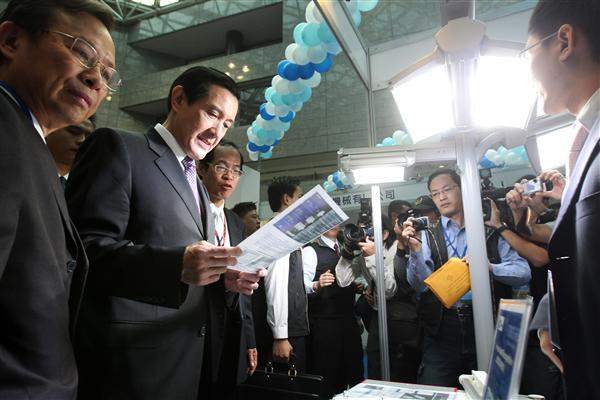News & activities
 News releases
News releases
President Ma Ying-jeou on the morning of December 14 attended the opening ceremony of the 2010 US-Taiwan Clean Energy Forum and Exhibition at the National Science and Technology Museum in Kaohsiung. Besides expressing his appreciation for the efforts of so many to achieve energy conservation and carbon reduction, the president said he hopes that Taiwan will transform from an information technology powerhouse into an energy technology powerhouse.
The president remarked that the ROC and the American Institute in Taiwan (AIT) have an ongoing environmental protection cooperation program that dates back 17 years. The two sides have thus far implemented 160 projects under the program. This relationship has strengthened bilateral exchange of technology, information, and human resources, and cooperation projects have been expanded to the regional level. The Kaohsiung exhibition displays the results of bilateral cooperation, and highlights the fact that the goals of sustainable economic growth and environmental protection can be complementary, he said.
President Ma commented that Taiwan is a major emitter of carbon and that it is among the world's leaders in trade. Even though the ROC neither has joined the United Nations Framework Convention on Climate Change nor is a party to the Kyoto Protocol, we have voluntarily announced carbon reduction goals, and tangible results have already been seen, he said. With greenhouse gases, for instance, the president cited data showing that Taiwan's emissions accounted for 0.97% of total world emissions in 2007, but had fallen to 0.899% in 2008. Per capita emissions consequently have fallen from 17th in the world to 18th. Meanwhile, Taiwan's carbon emissions in 2008 declined 4.1% from the previous year and fell another 4.9% in 2009. This demonstrates that the longstanding efforts here are starting to change the trend of carbon emissions, he remarked.
President Ma noted that the average global temperature has risen 0.74 degrees Celsius in the last century. Temperatures over the northern Pacific have increased 0.5 degrees, while Taiwan's average temperature in the lower elevations has climbed 1.2 degrees. Global warming has triggered increasingly extreme weather, where rain brings flooding and clear weather brings drought. The president explained that the government therefore put forward the concept of "saving the country through environmental protection" to help shape a better Taiwan. Work is also underway on the "four carbon reduction laws"—the Renewable Energy Development Act, the Energy Management Act, the Energy Tax Bill (draft), and the Greenhouse Gas Reduction Bill (draft)—and this constitutes practical action to address climate change. The government hopes that within the next eight years, energy efficiency will increase at least 2% annually, which will reduce energy intensity in 2015 by at least 20% in comparison with 2005 levels, and by over 50% by 2025. This would return Taiwan's 2020 carbon dioxide emissions to the 2005 level, and further reduce them in 2025 to the level seen in 2000, he said. President Ma remarked that Taiwan's green energy industries, such as photovoltaics and LED lighting, have already made considerable strides and that the government will continue to promote R&D work on wind power, biomass fuels, hydrogen power, fuel cells, energy information, and electric vehicles, so as to turn Taiwan into an energy technology powerhouse.
President Ma feels that besides government and industry, individuals also need to embrace energy conservation and carbon reduction habits in their daily lives to address the challenges of climate change. The president said that since taking office he has promoted gasoline, electricity, water, and paper conservation measures in the Presidential Office Building that have saved NT$7 million annually. He hopes that the public will follow this example by turning off lights when not needed, installing water-saving faucet washers, and taking public transport. Initiatives to create low carbon communities will be expanded to cover cities, regions, then the entire country, making Taiwan an environmentally friendly nation.
After concluding his remarks, the president, Environmental Protection Administration Minister Stephen Shu-hung Shen, Kaohsiung City Mayor Chen Chu, and AIT Taipei Office Director William A. Stanton pedaled bicycles to generate power for a couple of spotlights, formally making the opening of the exhibition. The officials then toured displays of solar panels and fuel cell vehicles.



